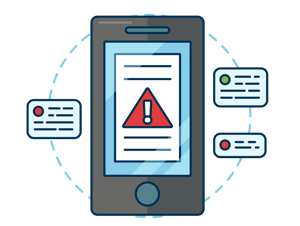By Florin R. Ferrs (Tech Writer)
IT professionals may believe that they are in the technology business, and of course, they are. But what if we told you that IT professionals are first and foremost in the customer service business?
This is a basic fact that sometimes gets forgotten or pushed under the rug. What this means is that if you are an IT professional or tech entrepreneur, you need to focus on developing and maintaining a strong customer service philosophy. Those that don't, do so at their peril and risk the success of their tech businesses.
But how can IT professionals maintain a strong customer service philosophy?
An Apology: A Real World Example
The following is a real world example of two mass emails sent out by a tech company to its customers (names have been redacted to protect the innocent, and not so innocent!).
Sent: August-10-20 10:20 AM
To: <redacted>
Subject: TBD
Dear <redacted>,
We are pleased to inform you that you have been accepted at Hogwarts School of Witchcraft and Wizardry. Please find enclosed a list of all necessary books and equipment. Term begins on September 1. We await your owl by no later than July 31.
Yours sincerely,
Minerva McGonagall
Deputy Headmistress
A short time later, once the news of this odd email began circulating among said tech company’s customers, social media and customer service reps, a prompt apology was issued via an email blast to the same customer list affected and on a discussion that had grown around the issue on social media (Twitter).
Here’s their apology email/social messaging:
We’re aware of the suspicious looking email that many of our customers received this morning. It was sent in error on our part. We apologize for the confusion and are reviewing our email marketing processes to avoid this in the future.
PS: We unfortunately lack the necessary authority to actually admit anyone to Hogwarts.
The above is a great example of how a well timed and well written apology can help a tech company get ahead of an escalating situation (especially if it has already reached social media, i.e. gone public). This prompt response reassures customers that the company is well aware of the situation, and that steps are being taken to rectify the problem and prevent it from happening again.
Any follow up messaging should focus on driving this home. The bit of humor they used in their apology (about lacking the authority to admit students to Hogwarts) offers a nice, light touch (but better used lightly, and only when appropriate). Overall, this is a great example of how your customer service philosophy (and hence the way you apologize to your customers when needed) should always put your customers' needs first.
Put Your Customers' Needs First
(Or: How To Avoid Needing To Apologize In The First Place)
But how do you put your customers first? This crucial reality of the IT industry begins with proper training. You have to provide your team with the tools they need to do their jobs as efficiently as possible. This includes tools like SherpaDesk’s knowledge base that can be used for onboarding, ongoing training, and to help your techs solve recurring customer problems more efficiently. 
Open Channels of Communications
Make sure that your customers know how to reach your support team at all times. Make sure that you provide a clear schedule of when your support team will be available via voice, email, or videoconference.
Empower Your Team to Solve Problems
Basically make sure that all your team members are well trained and empowered to make sure that the buck stops with each and every one of them. Obviously, some issues will always need to be escalated, but by empowering your team to solve your customers' issues before they turn into bigger problems, you will save having to do a lot of apologizing in the first place.
Empower Your Customers
Give your customers the tools they require so they can do their jobs. This includes designing a very intuitive UI/UX for your customers' benefit, and offering the right mix of tools that your customers need to do their jobs. This involves listening to your customers' feedback so you can implement the changes that they need first.
Provide Realistic Expectations
Make sure that you always provide realistic expectations and timelines. Nothing generates more customer dissatisfaction and the need for apologies than not being upfront with your customers about how long things will take or the kind of performance they should expect from your services or hardware.
Apologize When Things Go Wrong (and then make it right)
No matter how well trained your team is and how focused they are on customer service, the reality of the IT industry is that what can go wrong, will inevitably go wrong. There’s just too many factors that are sometimes out of your IT team’s control. Stuff will go wrong, that is a fact in the tech industry. So what really matters is letting your customers know in a timely manner that there is a problem, but that your team is working all hands on deck to fix it, while offering a realistic timeline of when they can expect things to be solved.
When To Apologize to Customers
(And How)
Tech professionals know that even the most well trained IT team will, sooner or later, run into customer service issues. The reason being is that the tech world is constantly under pressures that are beyond your IT team’s control like outages, hacks, natural disasters, hardware issues, software issues, and even (it’s 2020 after all) forest fires and pandemics. 
So When to Apologize?
Apologize promptly and often but focus on the affected customers. If the issue did not affect a specific portion of your users, then there's no need to get them involved. This also frees resources so your team can focus on the segment of your customers that are experiencing the problem.
How to Apologize
One on One
Reach out to the individually affected customers via email, phone, videoconference, or even in person. This approach ensures that your customers understand that everything is being done to solve their problem, gives them a realistic expectation of when things will get back to normal, and an assurance that your team is taking measures to prevent the issue from happening again. 
Mass Communications
Have a clear strategy set beforehand: A list of affected customers, a list of mediums to reach them, i.e. via internal email, in-app pop-ups, messaging, or social media.
Monitor the Fallout
Use social media to both communicate about ongoing problems and to nip in the bud any angry customers. Social media should be used to stay ahead of the situation while continuing to offer word class customer service during a crisis or ongoing problem. By responding to customers on social media, and apologizing when needed, your team is demonstrating publicly that you value your customers and are not afraid of engaging with them during tough times. Social media also enables your IT team to provide common answers or one on one solutions to ongoing issues or a query.
The Art Of The Apology Letter
We’re in the 21st century, but the art of writing an appropriate apology letter to your customers is just as valuable in today’s tech centric word as it has ever been.
 According to Hubspot, here are the nine most important elements that an apology letter should include:
According to Hubspot, here are the nine most important elements that an apology letter should include:
1-Say you're sorry.
(This one is self explanatory)
2-Admit you were in the wrong.
(As a tech company, being humble goes a long way)
3-Offer an explanation of what happened.
(Don’t talk down to your customers. Your customers are tech savvy)
4-Acknowledge the customer's goals.
(After all, you are here for them)
5-Give a clear next step.
(How and when will the issue be solved)
6-Ask for forgiveness.
(To err is human, what counts is how you plan to get it fixed)
7-Don't take it personally.
(Things happens. Set expectations early)
8-Provide customer feedback options.
(Provide a lot of means of communication: email, voice, social media, etc.)
9-Follow up with the customer.
(Keep all channels of communication open)
Compensation
Make sure compensation is always proportional. Most customers are happy with just having the issue solved.
Train your IT team to have a no questions asked approach to making things right i.e. don’t make your customers jump through hoops to receive a refund, or any kind of compensation expected after a problem, such as a refund for services not rendered correctly.
Apology Letter Sample
Here’s another real world example based on an apology letter sent by a tech company after a recent security breach. This example runs through most of the important touchpoints that should be included in a good apology communique in order to instill confidence in your team’s abilities to get a handle of the situation and reassures your customers that your company cares about what’s important to them.
Real World Example:
"Dear Valued Client,
We are writing to apologize and to make you aware of a security incident involving unauthorized access to our internal phone and information technology systems by an unknown third party. We are treating this matter with the highest priority and working with independent IT experts to conduct a thorough investigation and response.
Early this morning, we became aware that an unauthorized intruder had disrupted access to some of our internal systems. Upon discovery and out of an abundance of caution, we shut down points of access to external systems and immediately began investigating and remediating the problem. We have since engaged outside IT security and forensics experts to conduct a detailed review and help us securely restore affected equipment. We are implementing enhanced monitoring systems, and we have notified law enforcement.
At this time and based on the evidence available to us to-date, all indications are that the impact of this incident is limited to our internal network and phone systems. We currently have no reason to believe that any client data, client servers, or hosted systems were affected.
To ensure ongoing access to support services, we have posted a link to our online support tool on our homepage.
We are committed to completing a full forensics investigation and taking all appropriate actions in response to our findings. We will follow up with additional information as our investigation continues.
We apologize for any inconvenience this has caused and thank you for your patience as we remediate this situation.









comments